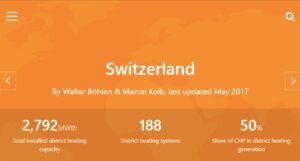
As of 2015, 4% of Swiss citizens were connected to a district heating network, of which 85.6% of the district heat was supplied from direct renewable energy and recycled heat. Although a small market share, district heat sales have been rising, growing from 4.4 TWh in 2011 to 5.1 TWh in 2015, which represents an increase of more than 15%.
As demonstrated on the graph, oil, especially for heating of existing buildings, plays a major role, followed by natural gas. The well-developed gas network allows natural gas to compete directly with district heating in urban areas. Furthermore, natural gas has been replacing other fossil fuels with a higher carbon footprint, such as oil and coal. As a result, oil no longer plays a significant role in new buildings and heat pumps have seen the greatest growth in recent years.

Around half of district heating is supplied through combined heat and power (CHP), which also contributes 2.4% to national electricity production in 2015. The main fuel source for CHP is waste with 40%, followed by natural gas and renewables with 29% and 25% respectively.
If you would like to learn more, you can purchase the latest Country by Country Survey.
Useful links:
Swiss District Heating Organisation